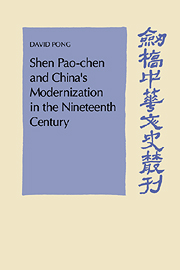Book contents
- Frontmatter
- Contents
- List of maps, tables, and figure
- Acknowledgements
- A note on spelling
- Abbreviations used in the notes
- Introduction
- 1 Early years
- 2 Local official in Kiangsi, 1856–1859
- 3 Governor of Kiangsi, 1862–1865
- 4 First encounters with foreigners
- 5 Director-general of the Foochow Navy Yard
- 6 The Foochow Navy Yard: early developments, 1866—1867
- 7 The Foochow Navy Yard: administration and personnel
- 8 The Foochow Navy Yard: building and training programmes
- 9 The Foochow Navy Yard: financial crises
- 10 The next steps in defence modernization: Ma-wei and beyond
- 11 Towards a plan for self-strengthening
- Conclusion
- Glossary of Chinese characters
- Bibliography
- Index
6 - The Foochow Navy Yard: early developments, 1866—1867
Published online by Cambridge University Press: 22 September 2009
- Frontmatter
- Contents
- List of maps, tables, and figure
- Acknowledgements
- A note on spelling
- Abbreviations used in the notes
- Introduction
- 1 Early years
- 2 Local official in Kiangsi, 1856–1859
- 3 Governor of Kiangsi, 1862–1865
- 4 First encounters with foreigners
- 5 Director-general of the Foochow Navy Yard
- 6 The Foochow Navy Yard: early developments, 1866—1867
- 7 The Foochow Navy Yard: administration and personnel
- 8 The Foochow Navy Yard: building and training programmes
- 9 The Foochow Navy Yard: financial crises
- 10 The next steps in defence modernization: Ma-wei and beyond
- 11 Towards a plan for self-strengthening
- Conclusion
- Glossary of Chinese characters
- Bibliography
- Index
Summary
The successful search for a director-general was a matter for self-congratulation. Shen was highly esteemed in Peking and at Foochow. As an imperial appointee bearing the title ch'in-ming tsung-li ch'uan-cheng tach'en (lit., by imperial command the high minister for the general direction of the shipping administration), he reported directly to the throne, though certain restrictions applied. Initially, he was empowered to memorialize independently, without having to secure the imprimatur of the high provincial officials. Problems that could not be solved locally were therefore guaranteed a hearing at Peking. However, the privilege was withdrawn two weeks later; Shen would now have to memorialize jointly with the governor-general and the governor at Foochow. Then, realizing that Giquel and d'Aiguebelle's confidence in the Navy Yard had been undermined by this arrangement, Tso Tsung-t'ang had his name added to the list of joint memorialists as a constant reminder to potential critics and opponents that the Navy Yard was Tso's creation and Shen his chosen director-general. But the arrangement did not restore Shen's independence.
Although Shen was often referred to as an imperial commissioner in Western sources, he was in fact a director-general by imperial appointment (ch'in-ming), not an imperial commissioner (ch'in-ch'ai). In official documents, he was simply addressed as the director-general of the shipping administration.
- Type
- Chapter
- Information
- Publisher: Cambridge University PressPrint publication year: 1994



